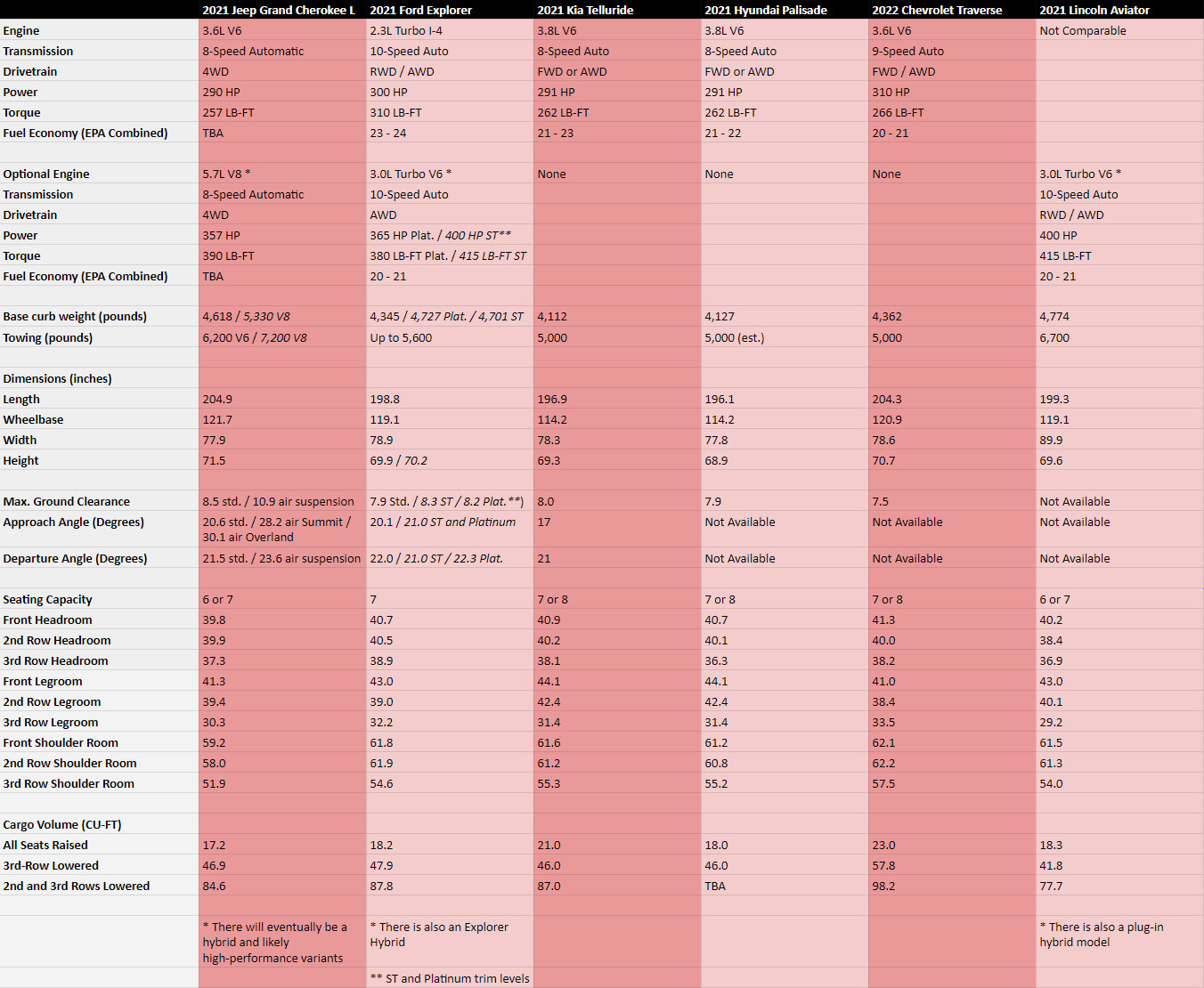The three-row 2021 Jeep Grand Cherokee L is here, entering an ever-growing segment of big crossovers that Jeep has ignored since the Commander of the late 2000s. Of course, the Dodge Durango has basically been a three-row version of the current Grand Cherokee with Dodge styling and a different interior, so it’s not like The Corporate Entity Formerly Known as Chrysler has been without a contender in the segment.
Jeep is a stronger brand than Dodge, however, and the three-row midsize segment is stronger than those with two rows (there’s a vast sales difference between the Chevrolet Traverse and Blazer, as well as the Honda Pilot and Passport). In other words, the Grand Cherokee L could be a very big deal. It is also, quite literally, a very big deal. As you’re about to see, it is now the largest three-row crossover, besting the length, wheelbase and height of even the gargantuan Traverse.
There’s more to the story than that, however, so we put together the below comparison chart to show you how the new Grand Cherokee L lines up on paper versus the biggest three-row crossovers. That includes the 2021 Ford Explorer, 2021 Kia Telluride, 2021 Hyundai Palisade and 2022 Chevrolet Traverse. This group also represents some of the strongest entries in the segment as well as those we feel are most likely to be considered alongside the big Jeep. To that end, we also included the 2021 Lincoln Aviator in the chart since its base price is actually less than what we anticipate the luxurious, range-topping Grand Cherokee L Overland and Summit trim levels to start.

Engines and drivetrains
Note the differences in curb weight here. The Grand Cherokee L has the highest base curb weight of the group apart from the high-lux Aviator, yet its 3.6-liter V6 has the least amount of power and torque. Therefore, it’ll be surprising if it’s not the slowest in the group. There’s of course the Hemi V8 available on the top Overland and Summit trim levels, but again, a hefty curb weight works against it. At 5,330 pounds, the lightest V8-powered JGCL weighs 600 pounds more than V6-power Explorer Platinum and ST models. On the other hand, nothing can touch the Hemi Jeep’s towing capacity, and only the 400-hp Aviator betters the Jeep’s base V6. Its 6,200-pound towing capacity greatly outdoes the 5,000-pound limits of not only the Telluride, Palisade and Traverse, but most others in the segment as well.
Then there’s the Grand Cherokee’s multiple four-wheel-drive systems, which we couldn’t possibly address in a spreadsheet. Three systems are available. The base version is a single-speed automatic system called Quadra-Trac I, which is essentially the AWD you’d get with the competitors. Quadra-Trac II is also an automatic system, but it adds a low-range gear set. Quadra-Drive II adds an electronically controlled limited-slip rear differential. All the Grand Cherokee’s four-wheel-drive systems can disconnect the front axle automatically when not needed to boost fuel economy.
Interior space
The Grand Cherokee L is shockingly larger on the outside than this group of vehicles, which were already awfully big. Nipping the Traverse is particularly surprising as it’s been the biggest crossover for basically ever, but the 8-inch gap between JGCL and the Telluride is almost shocking. This is a big vehicle.
Nevertheless, it doesn’t seem that exterior bulk translates proportionately to the interior as its dimensions are consistently the smallest in the group. Sure, specs often don’t tell the whole story about third-row or cargo space, but the numbers here are more indicative of slightly smaller three-row models like the Honda Pilot and Subaru Ascent. One reason for this could be the higher floor required to package Jeep’s burlier four-wheel-drive equipment and generous clearances. Its longer length could also be the result of a longer engine bay required to swallow a V8, but we’re just guessing here.
Clearances
No need to really dig too deeply here as the specs make it pretty clear, but if off-roading is on the table, the Jeep Grand Cherokee L is easily the best choice. Besides the multiple four-wheel-drive systems, its available air suspension has the ability to lift it far beyond what the others can manage. Even the base suspension has more clearance and a better approach angle than them all. Hyundai, Chevy and Lincoln don’t bother to provide such figures, and we can’t imagine many owners traveling too far off the beaten path in any of those.
How their interiors compare
We’ve only seen the swanky, leather-lined versions of the new Grand Cherokee interior, and considering how much of a difference there is between a current-generation Laredo and Summit, we’re not sure what might be in store for the new models’ lower trim levels. We also haven’t seen the JGCL in person, either. All of that said, it sure seems to give the others a serious run for their money in terms of design and materials quality, most notably the well-received Telluride and Palisade. The difference between it and the Explorer and Traverse would seem to be rather great, while it also seems like it might hold its own with the swank Aviator. Here are you can flip through some interior pictures to see for yourself.
How they compare in pictures
And finally, feel free to peruse these galleries of each three-row crossover.

